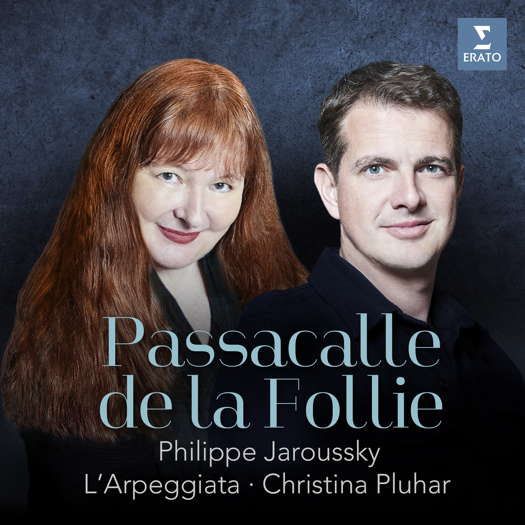- Paul August von Klenau
- American Four Seasons
- Cardiff
- Victoria Bond
- Marcello Viotti
- Gorj County
- Black Dyke Mills Band
- Richard Strauss: Till Eulenspiegel
ARTICLES BEING VIEWED NOW:
- Régine Crespin
- Hector Berlioz
- Ruth Railton
- Marián Varga
- Profile. A Very Positive Conductor - Paul Bodine talks to Los Angeles Opera's Music Director Designate, Domingo Hindoyan
 VIDEO PODCAST: John Dante Prevedini leads a discussion about The Creative Spark, including contributions from Ryan Ash, Sean Neukom, Adrian Rumson, Stephen Francis Vasta, David Arditti, Halida Dinova and Andrew Arceci.
VIDEO PODCAST: John Dante Prevedini leads a discussion about The Creative Spark, including contributions from Ryan Ash, Sean Neukom, Adrian Rumson, Stephen Francis Vasta, David Arditti, Halida Dinova and Andrew Arceci.

Musicians On the Road
GIUSEPPE PENNISI examines the Passacaglia and listens to a new Erato disc
'The interpreters, Philippe Jaroussky and Christina Pluhar's l'Arpeggiata, are excellent.'
What is the passacaille, the key subject of this CD? The passacaglia - in French passacaille, from the Spanish word pasacalle, in Italian also anciently passacaglio, passagallo, passacagli, passacaglie - is a musical form, of Spanish origin, based on the continuous variation on a theme. The name derives from Spanish and means to pass la calle, that is the road, a term that reveals the popular origin of wandering musicians. It is a well-determined derivation of the chaconne, with which it has great affinities. The passacaglia provides a melodic line, normally enunciated the first time alone. It can act alternately as a bass: in this case, it suggests harmony, as singing (and therefore can be harmonized in different ways) or as an internal part of a more elaborate composition. The chaconne, on the other hand, provides for a series of variations on a bass and is subject to an iron rule. It moves from tonic to dominant, with ascending or descending, chromatic or diatonic motion, but all with due and justified exceptions, and proceeds from its beginning to the end as a whole, following a univocal direction and considering the variations as an integral part of the entire composition.
The passacaglia later becomes a sort of folk dance, but in the Baroque period, it was practically monopolized by classical music, becoming a form widely used in the most disparate contexts. A famous passacaglia - La Folie d'Espagne - became one of the most popular themes throughout Baroque Europe.
Up to modern times, many composers have ventured to set it to music - for example Antonio Vivaldi, Arcangelo Corelli, Alessandro Scarlatti, Jean-Baptiste Lully, Francesco Geminiani, Marin Marais, Johann Sebastian Bach, Georg Friedrich Händel in the famous Sarabande, Antonio Salieri, Ludwig van Beethoven, Franz Liszt, Sergei Rachmaninov, and also famous virtuoso guitarists of the nineteenth century, such as Mauro Giuliani, Fernando Sor or even Ferdinand Rebay.
In addition to being a form in its own right - masterpieces of the genre are the Passacaglia in C minor, BWV 582, by Johann Sebastian Bach and the Passacaglia in D minor BuxWV 161 by Dietrich Buxtehude - the passacaglia can be a constitutive and integral part of other musical forms. For example, Bach himself uses it in the Crucifixus of the Mass in B minor, while Johannes Brahms uses it to finish the Variations on a Theme by Haydn and in the fourth movement of the Symphony No 4 whose passacaglia is built on thirty-five variations on the theme of the cantata BWV 150 by J S Bach. Also noteworthy is the passacaglia that opens Act V of Armide, the tragédie en musique by Jean-Baptiste Lully. In the twelve-tone field, Hanns Eisler uses the passacaglia in his Vierzehn Arten den Regen zu beschreiben, as a form for No 10, 'Soon etude'. This form has had great success with many composers of all ages.
As for the twentieth century, we should remember the famous Passacaglia for orchestra Op 1, the official compositional debut of Anton Webern and the third movement of Shostakovich's Concerto No 1 for Violin and Orchestra, Op 77.
I consider it useful to provide this background information because the booklet of this CD focuses on the passacaglia during the troublesome period of the succession, in France, from Louis XII to Louis XIV and on the passacaglia as 'courtly song' in those decades rather than on the music origin and style.
The CD includes sixteen different pieces and provides for an excellent anthology of French passacaglia. In short, it features all the main French composers who wrote airs de cour. The protagonist is Philippe Jaroussky, one of the main and most appreciated countertenors available internationally. He is accompanied by a specialized ensemble, l'Arpeggiata, which works with period instruments. The ensemble is conducted by Christina Pluhar.
I would suggest to start listening from track 6, Yo soy la locura, one of the two Spanish pieces on the CD and reportedly that which gave origin to the passacaglia as well as the title of the album.
Listen — Henry de Bailly arr Pluhar: Yo soy la locura
(5054197221873 track 6, 0:15-0:54) ℗ 2023 Christina Pluhar :
Then, I would go to track 13 to compare passacaglia with a ciaccona (by Robert De Visée).
Listen — Robert De Visée: Chaconne in G minor
(5054197221873 track 13, 0:00-0:37) ℗ 2023 Christina Pluhar :
I would, then, juxtapose a highly dramatic passsacaglia - Non speri pietà by Étienne Moulinié on track 3 - with a happy and brilliant one, also by Moulinié: Concert de differénts oiseaux - on track 14.
Listen — Étienne Moulinié: Non speri pietà
(5054197221873 track 3, 0:00-0:47) ℗ 2023 Christina Pluhar :
Listen — Étienne Moulinié: Concert de differénts oiseaux
(5054197221873 track 14, 3:47-4:23) ℗ 2023 Christina Pluhar :
This would give a listener in a hurry a good overview of the passacaglia in France during a period when the Court enjoyed music whilst complex (and cruel) succession plots animated politics.
The interpreters, Philippe Jaroussky and Christina Pluhar's l'Arpeggiata, are excellent.
Copyright © 4 March 2023
Giuseppe Pennisi,
Rome, Italy



